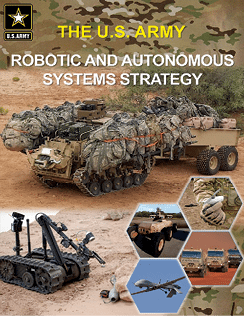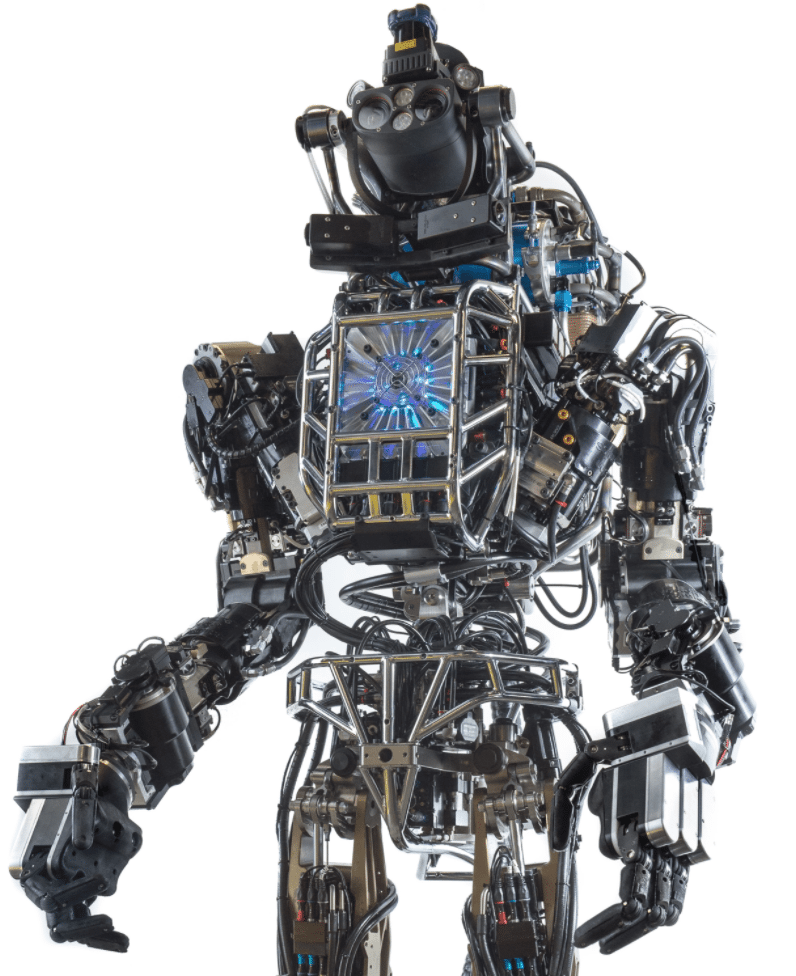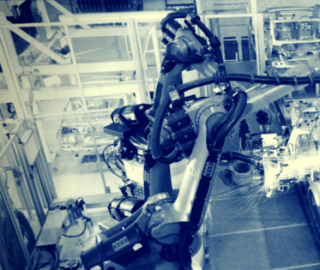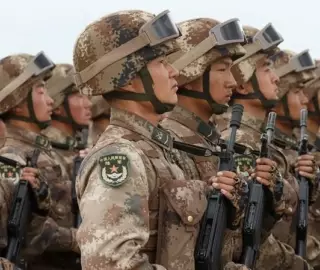
The market for military robotics is massive, and many developments can be observed in public competitions, university campuses, and DARPA’s own announcements.
Exactly how artificial intelligence will change militaries around the world is difficult to say. Predicting the development of any technology even with full information is complicated, but this is especially true of matters related to national security. Many of the latest developments are classified or selectively disclosed to serve propaganda purposes. Yet even with those constraints, it is possible to get a sense of how robotics and autonomous technology is already being used by militaries and the new applications they could potentially develop in the near future.
The potential benefits of autonomous militaries are numerous, which is why billions have been spent on autonomous military systems. This technology can cut down cost, improve effectiveness, allow militaries to operate more broad, and importantly help keep some humans out of harm’s way.
This article will examine the current state of military robots around the world and the possible future applications for some of these technologies:
- How military robots are being used on land, sea, and air
- What different major militaries around the world are doing with robots
- How non-state actors are using the technology
Government spending shows how much value the United States military puts on drones. In the FY17 budget proposal, the American military allocated approximately $4.61 billion to drone-related spending, and that doesn’t include highly classified spending on drones that might or might not be hidden in the so-called black budget, the details of how these funds are used is kept secret.
Last year $53.5 billion spend by 17 agencies under the National Intelligence Program and the Department of Defense got $16.8 billion for general Military Intelligence Program. The official spending includes the purchase of 31 unmanned aerial systems.
Military Robotics and AI – Background Info

Militaries all over the world have already developed robotics to be deployed on land, sea, and air. Just like autonomous technology in the civilian world, its benefits include reduced labor costs, reduced fuel costs, and reduced size for everything from automatic taxis to delivery drones; autonomous military vehicles provide all of these same advantages but with the additional benefit unique to militaries.
One analysis of the pro and cons of military robots highlighted, “First, autonomous weapons systems act as a force multiplier. That is, fewer warfighters are needed for a given mission, and the efficacy of each warfighter is greater. Next, advocates credit autonomous weapons systems with expanding the battlefield, allowing combat to reach into areas that were previously inaccessible. Finally, autonomous weapons systems can reduce casualties by removing human warfighters from dangerous missions.”
Robots can replace human in positions that are too dangerous or too dull. The military isn’t nearly as worried about robot being destroyed by enemy fire as they are about solider getting killed. Robots can also be sent into toxic environments.
These benefit, which is largely unique to militaries, made them one of the earliest adopters of autonomy and spurred them to invest significantly in it. According to BCG, global spending on military robots grew from just $2.4 billion in 2000 to $7.5 billion in 2015. BCG projects it will reach $16.5 billion by 2025, which can explain why 26 percent of new robotics companies since 2012 have been focused on military applications. This growth mirrors some of what we’ve seen in the industrial robotics sectors as well.
As a result, autonomous military equipment is already being deployed to replace people in some of the most dangerous, physically grueling, and mentally taxing duties. Companies and militaries are continuously announcing new autonomous systems to keep soldiers out of harm’s way.
Militaries around the world are looking for ways to just autonomous system in every possible field including land, air, and sea. This article will look at some of the uses in each these areas.
(Readers with a more general interest in robotics might enjoy our full article on machine learning in robotics.)
Land
On the battlefield, militaries and companies are trying to replace soldiers with combat vehicles operated with robots, allowing militaries to engage the enemy without putting their own troops at risk. Robot tanks, trucks, and sentries are being developed by replace humans in possible dangerous environments.
Remote Control Tanks – Russia, Uran-9
A year and a half ago, Russian defense contractor Rosoboronexport unveiled their remote control tank, the Uran-9. The tank has advanced target detection and identification systems allowing it to be operated by just one person. In addition to full operation under manual control it can function autonomously under limited conditions.
The 10-ton tank features a 30mm cannon and missile launching capacity. It is expected to be deployed in the Russian army and offered for export. It is designed with urban combat and counterterrorism in mind. The Uran is far larger and better armed than smaller TALON robots, which have been used by the United States since 2000 to remove bombs and remote firing of small arms.
Robot Sentries – South Korea, Samsung SGR-A1 and DoMaam Super aEgis II
South Korea, with its long, heavily defended border with North Korea, has used a simple AI sentry guns for years. They are fixed location piece of equipment that watches for and responds to possible threats. The Samsung SGR-A1 was developed in 2006 and reportedly deployed in 2010 along the demilitarized zone.
A similar system developed by DoMaam Super aEgis II was also unveiled in 2010. It can detect human at 3km during the day and 2.2 km at night. They are normally equipped with a 127mm caliber standard.
The pattern recognition and tracking software in these systems can automatically detect humans trying to cross the border, issue verbal warnings and even open fire, if given approval by a human operator. This type of system has been deployed along hostile borders because robots already well outperform individuals when it comes to standing perfectly still and patiently watching for small changes.
Sea
Beyond just keeping personnel out of harm’s way, unmanned naval vessels don’t need to feed, hydrate, entertain human crews, or keep them warm. No sleeping quarters or bathrooms either. This potentially would allow unmanned vessels to be much smaller and operate for much longer, which is partly why they have generated significant research and development investment.
Autonomous Ships – United States, DARPA’s Sea Hunter
DARPA’s Anti-Submarine Warfare Continuous Trail Unmanned Vessel, dubbed the Sea Hunter, has been under development since 2010 and was demonstrated in 2016. It is currently undergoing open water testing of its autonomous systems and could be handed off to the Navy by 2018. Eventually, the vessel is intended to travel thousands of miles and for months on end without a human crew.
The goal of this vessel is to track quiet diesel electric submarines but also to test the possibility of completely unmanned vessels in general. Once the technology is fully tested, it can potentially be used for any type of naval vessel including ones intended for direct combat. Not only would that increase a country’s ability to project power around the globe but it could theoretically produce dramatic cost savings by reducing the need for human crews and cost of adding equipment to vessels that are need to keep humans alive.
The U.S. Defense Department believes it will eventually cost only $15,000 to $20,000 a day to operate ships like the Sea Hunter, while by comparison it currently costs $700,000 to operate a traditional destroyer.
Air
Military drones, or unmanned combat aerial vehicles (UCAV), are one of the oldest and most widely used military robot technologies. Their use goes back over four decades. One of the first military applications of unmanned aerial vehicles was by Israel in 1969. Israel effectively converted toy remote planes for surveillance work by equipping them with simple cameras to gather information just across their border with Egypt.
Since then, UCAV have grown significantly more complex and versatile with a wide spectrum of different shapes and sizes. Surveillance continues to be a major use for them for militaries small and large, but they are also used as a weapons platform to directly engage enemy targets.
The United States’ use of Predator drones equipped with Hellfire missiles is the most famous and common example. They have been used for thousands of strikes around the world since 2002. The Predator drone is being retired and replaced by the newer MQ-9 Reaper, which can fly faster, longer, and carry a larger weapons payload. The MQ-9 Reaper is capable of both remote control and autonomous flight. General Atomics recently won a $400 million contract to produce 36 more of them.
Drone Swarms – United States, Perdix Drones
For surveillance purposes, military drones continue to get smaller, more reliable, and smarter. Some of the most advanced examples currently in existence are the micro-drones Perdix recently demonstrated to the U.S. Department of Defense. The Perdix drones can be deployed in large numbers and automatically communicate with each other to make decisions.
“Due to the complex nature of combat, Perdix are not pre-programmed synchronized individuals, they are a collective organism, sharing one distributed brain for decision-making and adapting to each other like swarms in nature,” said SCO Director William Roper. “Because every Perdix communicates and collaborates with every other Perdix, the swarm has no leader and can gracefully adapt to drones entering or exiting the team.”
Cheap networked drones could find many uses. The multipoint surrivlence of a swarm can provide a rich and more complete real time data about the battle field. They could also be use to jam enemy communications or serve as a communication network.
Ultra Tiny Drones – Norway, Black Hornet
While drones at higher altitudes can provide a macro level of information, some companies are also producing ultra small drones the size of hummingbirds to provide individual soldiers with information about what is literally just around the corner.

Norwegian Prox Dynamics, which was later acquired by FLIR for $134 million, created the Black Hornet. It was the world’s first operational Personal Reconnaissance System to be deployed by a military when UK forces used it in Afghanistan in 2012. Since then, an updated version has been purchased for use by Norway, Australia, Germany and the United States.
The ultra small drone can be carried and quickly deployed by a soldier in the field to scan the local area with vision or infrared cameras from a place of relative safety. The feed is beamed back to the soldier on a small Ipad like display.
Non state Actors
Robotics is not just changing the way major powers are waging war but also changing how small countries, rebel groups, terrorist organizations and other non-state actors fight.
The rapid drop in the cost of small commercial drones is making it possible for armed groups with even very limited resources to make use of this technology. Non-state actors are using drones both for simple surveillance and weaponization. Back in 2016 ISIS started attaching explosives to hobbyist drones and has managed to inflict casualties with this tactic. Simple quadcopters can be modified to drop bombs or function as low-cost guided weapons. As robots in general get cheaper and more readily available, it will be easier for groups to weaponize them.
The Future of Military Robotics

A Harvard Kennedy School analysis on AI’s possible impact on national security highlighted a powerful analogy from Former Gill Pratt, DARPA Program Manager. He likened the current state of robots to the “Cambrian Explosion.”
There is a period in time roughly half a billion years ago during which the fossil record quickly went from only simple life to a dramatic explosion of complex life of every imaginable shape, size, and mode of movement. Not all these of animal designs survived, but it seems as soon as complex life became possible, animals evolved quickly to try to find every possible niche.
This analogy feels particularly applicable for military robots. It is only in the past decade or two that computer processing, sensors, data storage, etc… have made many of the applications possible, and as a result we are seeing companies and militaries testing out how robots can fill every niche on the battlefield, from drones the size of small birds to large tanks.
We are seeing the use of device ranging from stationary autonomous sentries guns to swarms made up of over a hundred drones, all intelligently working together. Government agencies and companies are even working towards creating humanoid and doglike robots capable of walking, running, jumping and using hands. Robots that could possibly at some point replace everything human soldiers do, and there’s an undeniably large market for just those kinds of soldierly tasks – which is one of the reasons that we suspect to see more defense-oriented firms in our robotics vendor company list in the 2-3 years ahead.
It is likely too early to know which particular forms and military applications would be most viable long term, but the current successful use of some military robots indicates there niches that militaries benefit from having robots fill and many more they want to see filled.
Conclusion

The specific need to try to keep personnel out of the line of fire makes the economics behind military robots unique compared to commercial applications. For militaries, robots don’t technically need to be cheaper, better, or faster for it to be worth spending money on, as long as as they can keep a soldier from needlessly getting in harm’s way – or keep a nation ahead of it’s greatest ally should an all-out war occur.
As a result, defense is often be one of the first sectors from which a new type of robot gets investment, and there will likely be many robotic applications that only make financial sense for the military. Indeed, early funding for robotics, AI, and neurotechnologies have often been led by the government (at least here in the US).
That said, much of the same technology driving the use of robots in the commercial space is also driving the use of robots in the military space. Many of the reasons companies are turning to robotics for commercial applications like self-driving cars or delivery drones — such as labor costs, reduced fuel use, improved accuracy etc. — are all also valuable to militaries.
That is why you see military sometimes borrowing from the civilian world and other times is the driving force behind new developments, especially in robotics. For example, DARPA’s Grand Challenge helped drive autonomous car development in the earliest days. It is likely many of these military system will filter down to the civilian world in some way.
The military robots currently being used to replace personnel in particularly dangerous positions will likely be only the start. Fighting robots make headlines and are the most valuable when it comes to protecting soldiers, but a huge amount of any military budget is logistics. All the same autonomous applications to improve trucking and shipping that are currently being developed for civilian applications would be equally useful to most militaries, once they get to the right price point. These use of “military” robots could eventually be as significant as the use of robots in the theater of war.
Header image credit: Military.com







